If you’re living in South Carolina, you may have noticed an increase in the geese population over the past few years. While these birds can be beautiful to see, they can also be quite troublesome. In this guide, we will discuss everything you need to know about geese in South Carolina.
What kind of geese species are in South Carolina?
There are three types of goose in South Carolina:
- Canada Goose
- Snow Goose
- Cackling Goose
Canada Goose
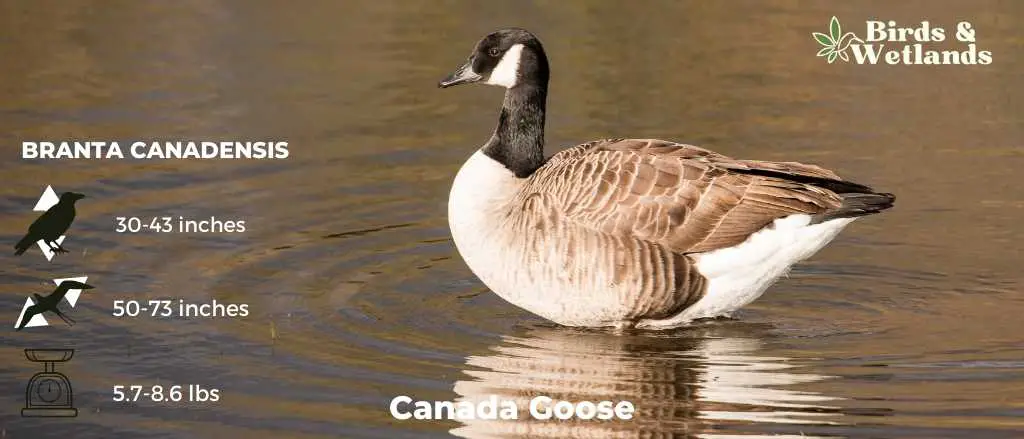
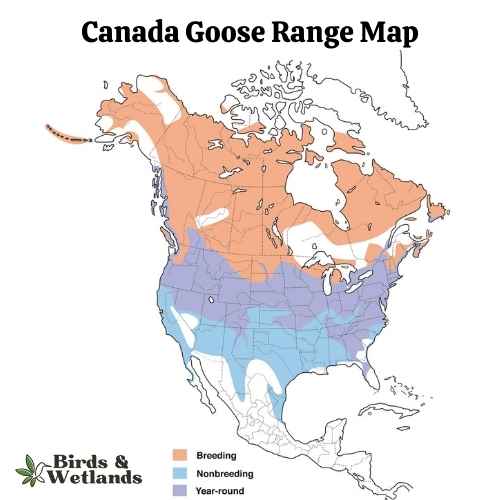
Canada Goose Sound
Scientific Name: Branta canadensis
Length: 30 to 43 in
Wingspan: 50–73 in
Weight: 5.7–14.3 lb
The Canada Goose is a large, well-known species of waterfowl noted for its distinctive appearance, familiar “honk,” and migratory behavior.
Appearance: Both male and female Canada Geese have a similar appearance, featuring a black head and neck with distinctive white patches on the cheeks and chin. The body is primarily brown with a lighter, often white, underbelly.
Diet: Canada Geese primarily feed on plant matter, including grasses, aquatic vegetation, and grains. They can often be seen grazing in parks, lawns, and fields, as well as dabbling in water bodies.
Reproduction: Canada Geese typically nest on the ground near water bodies, often on islands or other isolated areas to avoid predators. The female lays a clutch of about 4 to 6 eggs, which she incubates alone for around a month.
Cackling Goose
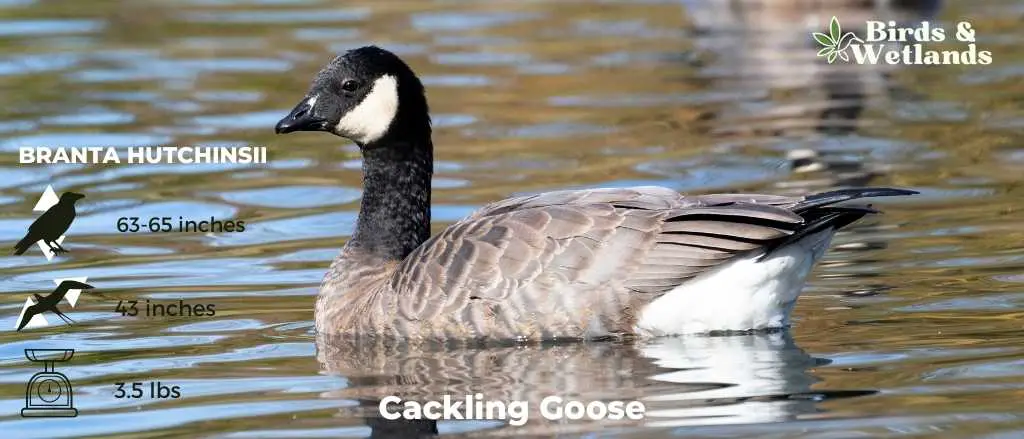
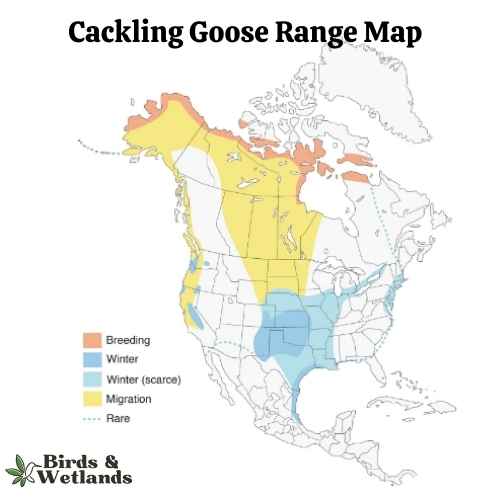
Listen
Scientific Name: Branta hutchinsii
Length: 24.8–25.6 in
Wingspan: 43-45.7 in
Weight:3.5 lbs
Cackling Geese are particularly known for their high-pitched, cackling calls, which is the source of their name. Despite their small size, these geese are renowned long-distance migrants, with some populations traveling thousands of miles between breeding and wintering grounds.
Appearance: With a similar color pattern to the larger Canada Goose, the Cackling Goose features a black head and neck, white chinstrap, light tan to cream chest, and brownish-grey body. One defining characteristic is its noticeably smaller size and stubbier neck compared to its larger counterparts.
Diet: Like many geese, the Cackling Goose’s diet mainly consists of plant matter. This includes grasses, seeds, and aquatic vegetation. They are often seen grazing on land or dabbling in shallow water.
Reproduction: Cackling Geese usually nest on the ground in elevated areas near water bodies, such as riverbanks or lakeshores. The female lays a clutch of 2 to 8 eggs and is responsible for incubation, while the male stands guard nearby. Incubation lasts for about a month.
Snow Goose
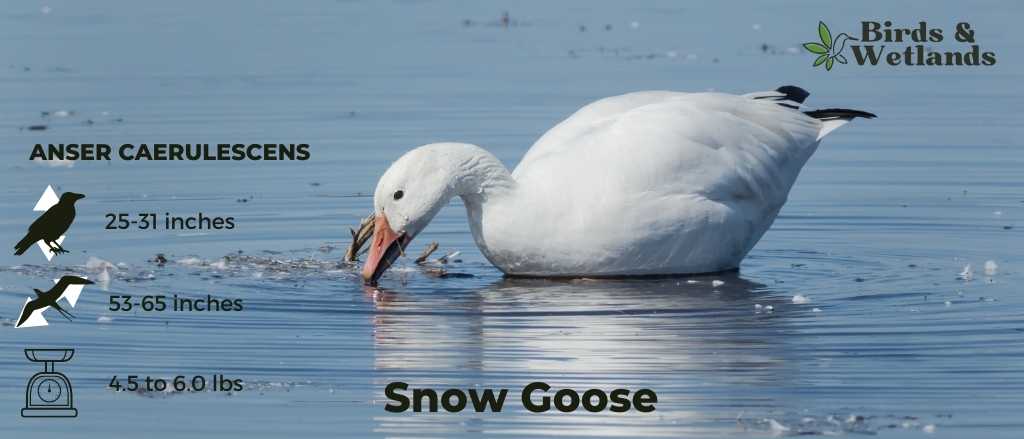
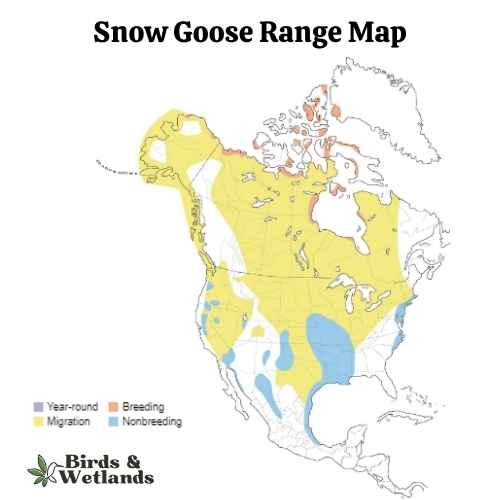
Snow Goose Sound
Scientific Name: Anser caerulescens
Length: 25 to 31 in
Wingspan: 53 to 65 in
Weight: 4.5 to 6.0
The Snow Goose is a large species of waterfowl known for its vibrant white plumage and significant migratory flights.
Appearance: True to their name, Snow Geese are predominantly white with black wingtips. They also have a pink bill, pink legs and feet. A color morph, known as the “Blue Goose,” displays a bluish-gray body with a white head, but is considered the same species.
Diet: Snow Geese primarily feed on plant matter, such as grasses, sedges, and small grains. They can often be seen in large flocks foraging in fields and marshes, and during migration and winter, they can cause considerable damage to agricultural fields due to their feeding habits.
Reproduction: Snow Geese typically nest on the tundra, near water bodies. The female builds the nest and lays a clutch of about 3 to 5 eggs, which she incubates alone for approximately three weeks. Once hatched, the goslings can feed themselves but stay with their parents for protection until they can fly.
Are There Resident Geese Flocks in South Carolina?
Yes, there are resident Canada geese who live all year round in South Carolina, it’s estimated this population is about 50,000. There are resident Canadian geese all across the state, but the areas with the highest concentrations of these birds include the Upper Coastal Plain, Piedmont, and the Foothills.
There are also two groups of Canada geese who migrate hear each year in the winter months. Canada goose populations have really grown in recent years and some estimations are that they are growing at a rate of 10% year on year.
Whilst these majestic creatures are a delight to see, they can become a nuisance as their overpopulation drains natural resources. These large birds are attracted by the large lakes (for the aquatic vegetation) and golf courses, as well as the farm fields in the state. Geese can also be aggressive to humans if you go near their nests.
There are no natural predators to these large flocks which is allowing their populations to climb, however, this can lead to issues with goose droppings (they poop up to 2lb a day!) and as they overfeed in grain fields. golf courses and grassy areas, destroying the crops.
The wildlife service will give you a permit to remove a nest site from your property if they are causing a nuisance. They may be attracted to your garden if you have a small pond or water source present, read our guide to getting rid of geese of your property.
Are geese protected in South Carolina?
Yes, across America all native waterfowl like ducks and geese are protected by the Migratory bird treaty act. During the breeding season, it is unlawful to hunt geese.
Can You Hunt Geese in South Carolina?
Yes, hunting is permitted during the hunting season as long as you have a valid permit and licence and stick to the bag limits and possession limits which can be found here.


